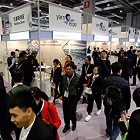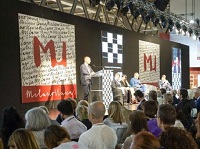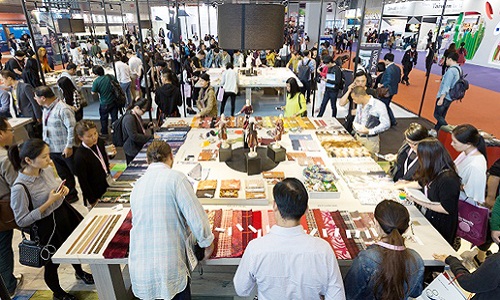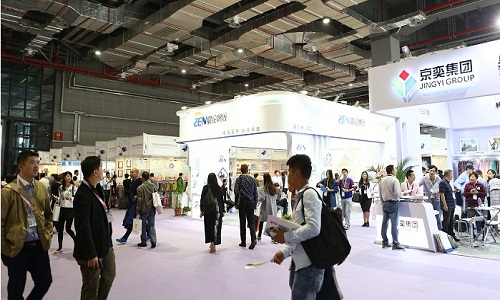FW
"China has been playing an increasingly important role in the global yarn and fibre industry, not only as a strong buyer but also as a high-quality supplier that is looking to exports. As a result, a significantly higher number of Chinese exhibitors will feature at next month’s Yarn Expo Spring including some of the industry’s biggest names, reflecting the fair’s leading position in the country. Over 275 domestic exhibitors (2016: 150) have already confirmed their participation, which is schedule from March 15 – 17, in hall 5.1 of the National Exhibition and Convention Center (Shanghai)."

China has been playing an increasingly important role in the global yarn and fibre industry, not only as a strong buyer but also as a high-quality supplier that is looking to exports. As a result, a significantly higher number of Chinese exhibitors will feature at next month’s Yarn Expo Spring including some of the industry’s biggest names, reflecting the fair’s leading position in the country. Over 275 domestic exhibitors (2016: 150) have already confirmed their participation, which is schedule from March 15 – 17, in hall 5.1 of the National Exhibition and Convention Center (Shanghai). Together with the international exhibitors from 10 countries and regions, the fair is expected to host over 360 exhibitors.
Display Zones
These domestic exhibitors will showcase a diverse selection of innovative yarns and fibres, such as nylon, viscose filament, renewable & recycled fibres and much more under five distinctive display zones:
Fancy Yarn Zone: Nearly 50 exhibitors, including some leading suppliers like Dongguan Jiancheng Textile, Hangzhou Hengniu Fancy Yarn, Jiangyin Haoqiang Textile, Yiwu Heny Imp.Exp and Zhejiang Longyou Chaobao Textile, will bring together the latest collections of creative and trendy fancy yarns.
Natural Cotton Zone: Around 100 of China’s top cotton yarn suppliers will exhibit high-end cotton yarns as well as new imitation varieties, such as vortex spinning and differentiated yarns. In addition, four regional pavilions from Henan, Fujian Changle, Jiangxi and Xinjiang can also be found here.
Colourful Chemical Zone: Four theme areas – China Fibre Trend Area 2017-18, Ecology & Functional Area, Fashion & Technology Area and Green & Eco-friendly Area – will host the foremost Chinese fibre brands with a wide spectrum of innovative and eco-friendly low carbon fibres.
Quality Wool Zone and Green Linen Zone: The focal point for outstanding wool and linen yarns and fibres Shenghong China Fibre Trend Forum 2017-18 illustrates ‘Fibres Change Life’ concept. Located in the Colourful Chemical Zone, Shenghong China Fibre Trend Area 2017-18 will reveal the concept of ‘Fibres Change Life’ through demonstrations of various cutting-edge fibre products, and the latest technologies and trends.
Concurrent shows
Yarn Expo Spring will showcase some of the world’s highest quality yarn and fibre products, such as natural and blended yarns including cotton, wool, flax/regenerated flax, silk, and man-made fibres and yarns, as well as specialty products including elastic, and fancy and blended yarns. Along with Yarn Expo Spring 2017, four other textile trade fairs are held concurrently in the same venue: Intertextile Shanghai Apparel Fabrics – Spring Edition, Intertextile Shanghai Home Textiles – Spring Edition, PH Value and the China International Fashion Fair (CHIC). Yarn Expo Spring is organised by Messe Frankfurt (HK) Ltd; The Sub-Council of Textile Industry, CCPIT; China Cotton Textile Association; China Wool Textile Association; China Chemical Fiber Association; China Bast & Leaf Fibres Textiles Association; and China Textile Information Centre.
"Amongst the many high-quality offerings at Intertextile Shanghai Apparel Fabrics’ premium SalonEurope is the Milano Unica Pavilion, which will feature again at the 2017 Spring Edition in March. This follows the huge success of the last October edition. The pavilion, which is by invitation only, recorded a 20 per cent increase in buyers compared to the Autumn edition. Moreover, the organizers were pleased with not just this growth but a rise in quality of the buyers as well. “We registered an important increase in high quality clients,” says Ercole Botto Poala, President, Milano Unica."

Amongst the many high-quality offerings at Intertextile Shanghai Apparel Fabrics’ premium SalonEurope is the Milano Unica Pavilion, which will feature again at the 2017 Spring Edition in March. This follows the huge success of the last October edition. The pavilion, which is by invitation only, recorded a 20 per cent increase in buyers compared to the Autumn edition. Moreover, the organizers were pleased with not just this growth but a rise in quality of the buyers as well. “We registered an important increase in high quality clients,” says Ercole Botto Poala, President, Milano Unica.

Now, Milano Unica is optimistic about the coming edition, with Poala noting exports of Italian textiles to China grew by around 3 per cent in 2015, and in 2017, he expects demand for Italian women’s wear fabrics to grow. “2017 will be a positive year not only for menswear fabrics. Comments from the womenswear textile mills (at the fair) highlight a constant increase in quality visitors and knowledgeable choices of products,” he said.
Zones a top attraction
SalonEurope also attracts buyers looking for high-quality offerings with its country pavilions. This edition includes: France and Germany Zone. Since its debut in 2015, the France Zone has become an instant favourite among buyers thanks to the top brands exhibiting there, which in this edition include: Goutarel SA, Malhia Kent, Promostyl and Solstiss Sarl. Germany Zone will also feature well-known industry names including Transfertex, a leader in pattern designs and digital & transfer printing, and Union Knopf with its wide range of quality accessories. Apart from these three countries, individual exhibitors from Denmark, Switzerland, Turkey and the UK are amongst those already confirmed to exhibit in SalonEurope.
Asia shines through
Asia is well represented again at Intertextile Shanghai, with country and region pavilions from Japan, Korea, Taiwan, India and Pakistan housed in the International Hall. The Japan Pavilion, organised by Japan Fashion Week Organization, will feature exhibitors of high-quality cotton, man-made and knitted fabrics, and lace and embroidery for womenswear. The Korea Pavilion will highlight the country’s expertise in innovative products, with a range of man-made and functional fabrics on offer thanks to the Korea Fashion Textile Association. The Taiwan Textile Federation’s Taiwan Pavilion will showcase knitting fabrics, lace and embroidery, functional and man-made fabrics, as well as blended yarns.
Representing India for the first time at the fair is the Powerloom Development & Export Promotion Council Pavilion. Exhibitors in this pavilion will highlight their cotton, linen/ramie, man-made and lace and embroidery products. The Pakistan Pavilion, organised by the Commercial Section, Embassy of Pakistan features exhibitors of cotton fabrics for casual wear and jeans wear.
Lenzing Group Pavilion
As one of the industry’s leading innovators, Lenzing will organise their own group pavilion for the first time to allow partner mills to showcase cutting-edge textile products. Nearly 25 of these mills will exhibit a range of cotton, man-made, knitted, lace and embroidery, and fibre and yarn products made from Lenzing’s raw materials.
Concurrent shows
In addition to Intertextile Shanghai Apparel Fabrics, four other textile fairs are happening concurrently at the National Exhibition and Convention Center, Shanghai. These include Yarn Expo Spring (Hall 5.1), Intertextile Shanghai Home Textiles – Spring Edition (Hall 4.2), CHIC (Halls 1, 2, 3 & 4.1) and PH Value (Hall 3). Intertextile Shanghai Apparel Fabrics – Spring Edition 2017 is co-organised by Messe Frankfurt (HK; the Sub-Council of Textile Industry, CCPIT; and the China Textile Information Centre.
DuPont’s renewably sourced fiber Sorona has been chosen runner-up for Fiber Producer of the Year by the World Textile Awards.
Sorona is an illustration of DuPont’s commitment to developing and delivering exceptional products that benefit every level of the supply chain. Sorona is derived, in part, from renewably sourced plant-based ingredients, allowing for a decreased dependence on fossil fuels and reduction in greenhouse gas emissions. In addition to sustainability, it offers unique performance benefits including superior softness, unmatched durability and inherent stain resistance without the need for topical treatments. As a multipurpose fiber, it can be used alone or combined with synthetic or natural fibers for different benefits and endless options.
World Textile Awards are dedicated to recognizing and rewarding excellence across the global textile industry. Companies are assessed on their market position, technical performance, environmental and sustainability practices, quality control and employee programs.
DuPont has been bringing world-class science and engineering to the global marketplace in the form of innovative products, materials, and services since 1802. The company believes that by collaborating with customers, governments, NGOs, and thought leaders it is possible to help find solutions to such global challenges as providing enough healthy food for people everywhere, decreasing dependence on fossil fuels, and protecting life and the environment.
UK apparel and textile exports rose almost seven per cent from last year, with a 28 per cent increase since 2012. The rise has come on the back of increased interest in heritage UK manufacturing, the creativity of British fashion designers and the importance of the UK as a key apparel trading hub.
However, there could be disruption ahead as the country extricates itself from its long-term membership of the EU. In 2016 the European trade bloc was the UK’s biggest export market and accounted for 74 per cent of the products it exported.
Britain’s apparel and textile exports to the EU rose 36 per cent from 2012 to 2016. But imports also rose with the UK trade deficit increasing. Many UK fashion chains import yarn and some manmade materials from abroad, making them vulnerable to currency fluctuations. If they import from China or India, the cost of yarn and raw materials are US dollar denominated. That impacts on the cost. Aside from rising costs, there is the potential impact on tariffs from a hard Brexit.
If the UK does not reach a post-Brexit trade agreement with the EU by 2019, the nation could be forced to use World Trade Organisation rules. This would mean tariffs on food and clothing rising sharply, with clothing and footwear prices going up by 16 per cent.
By 2025, Levi Strauss plans to manufacture all its products from recycled cotton. It would be the first company to do so. So it will stop using cotton sourced from cotton fields to make its famous 501s, relying instead on old clothes from people’s closets. Currently, a fifth of all the cotton Levi’s uses comes from recycled sources, with the rest coming from virgin cotton. To raise that ratio to 100 per cent recycled material will depend on innovations in science.
Levi Strauss runs a program in five major markets - Japan, the United States, Canada, the United Kingdom and Germany - that gives customers a 15 per cent discount on a new Levi’s item if they donate any old clothes (they don’t have to be Levi’s) to be recycled. Sustainability has long been a point of difference for the brand. It was not only the first apparel company, but the first multinational to introduce a labor code of conduct in 1991, to ensure that the workplace standards and business practices of its suppliers lived up to its own.
The supply chain has been the focus of Levi’s sustainability efforts, and the company also aims to expand its water-less program, so that 40 per cent of its products are made using less water by 2020.
Bilateral trade in goods between Bangladesh and the United States declined slightly in the last calendar year. Both imports from Bangladesh to the US and exports from the US to Bangladesh declined in 2016. Bangladesh has long been urging the US to allow it tariff-free market access.
The US has already granted unilateral tariff-free market access to African and Caribbean less developed countries. Only Bangladesh, Cambodia, Nepal and a few other Asia-Pacific less developed countries are yet to get the access. Meanwhile, Bangladesh’s apparel exports to the United States dropped marginally last year, by 1.8 per cent, compared to 2015.
In fact, except Vietnam, all the top 10 apparel exporting countries faced a downward trend in exports last year to the US. Apparel exports from Vietnam registered a modest 2.3 per cent growth. Export from China, the top apparel source of the US, declined by 8.38 per cent. Indonesia, the fourth largest apparel exporter to the US market, faced a 4.68 per cent decline, followed by Honduras which suffered a 4.47 per cent fall in apparel exports. Apparel exports from India to the US declined marginally by 0.69 per cent while Cambodia faced a 13.63 per cent decline last year.
The Indian textile chemical market is driven by investments by industry players for the development of eco-friendly chemicals. A thrust for export of quality textiles to western countries is also positively driving the textile chemicals market. Textile chemicals are a class of specialty chemicals that are used for dyeing and processing of textiles in order to obtain the final product with the required characteristics.
The Indian textile chemical market is highly fragmented with a presence of more than 300 small and large players. The presence of a large number of players is attributed to the heavy subsidies provided to small players for setting up business operations. This accounts for the majority share being held by minor players.
However, the share of small textile chemical manufacturers is expected to decline in the coming years due to the increasing preference for quality products and the increasing penetration of technical textiles. Auxiliaries will account for a major share of Indian textile chemical market.
The textile chemical industry is a major consumer of water and energy. The use of novel textile processing techniques such as beck dyeing modification, dye bath reuse, close cycle textile dyeing, foam process, mach nozzle fabric drying, and ink and film application can reduce water and energy consumption in the textile chemicals industry.
In 2015-16, the Indian sportswear market grew 22 per cent, outpacing the segment’s global increase of seven per cent. By 2020, it is expected to grow at 12 per cent CAGR. Nearly 80 per cent of India’s sportswear market is dominated by global brands like Adidas, Reebok, Nike and Puma, with others such as Under Armour, Fila and Lotto, domestic multi-brand sportswear retailers like Planet Sports and Royal Sporting House, and emerging local players, collectively battling for the remaining 20 per cent.
Between the Big Four, Adidas currently holds a 45 per cent market share, operating 760 stores through the franchise mode. Competitors like Puma and Nike also run their operations in the country through franchising — all of Nike's 200 outlets are licensed by local franchising partners.
Driven by the country's growing wealth, changing lifestyles, and rising urbanisation, an increasing amount of Indian consumers are becoming more health conscious. This makes the country’s sportswear sector increasingly attractive to a host of local and international brands. Over the years, a flood of local franchisees have got into business with aspirational sportswear brands, facilitating a rapid expansion of their presence throughout India.
Between 2015-16, sportswear in metro and Tier II and III cities grew close to 80 per cent. The footwear category grew 100 per cent for metro and Tier II cities and there’s also a strong demand from Tier III cities which grew over 110 per cent.
H&M’s January sales rose by eight per cent. It is targeting an annual local-currency sales growth of 10 to 15 per cent and expects to be within that range from this year on. The Swedish fashion retailer the world’s second-biggest clothing firm after Inditex, saw slow sales growth and a dip in profits last year, is branching out into more brands to reach more customers and investing heavily to speed up supply and improve its online range in response to tougher competition in its budget segment and from online-only players.
H&M had 4,380 stores as of end of January, up 11 per cent from a year ago. The company recently replaced a long-standing 10 to 15 per cent annual store growth target with a turnover target to reflect growing e-commerce.
The company plans to add e-commerce in 11 markets and open 425 net new stores this financial year. In 2017, H&M intends to open stores in four to five new markets, including Colombia, Iceland and Kazakhstan. Europe’s fashion retailers have been suffering lately from an unseasonably warm end to summer and a lack of compelling fashion trends. Business conditions are close to a recession. Price competition in the industry is escalating.
Global textile and yarn makers see Bangladesh as a potential market. Though fabrics and yarn are being locally made, Bangladesh still needs to import a good quantity to meet the growing demand. In Bangladesh, local spinners meet over 90 per cent of the demand for raw materials of the knitwear sector and over 40 per cent demand of the woven sector.
The demand for specialised textiles like linen is very high in Bangladesh, which is quite capable of supplying fabrics in bulk to garment makers. Chinese companies see Bangladesh as their future market as China has been losing market share in the global apparel business. Some of them plan to open offices in Bangladesh since the fabrics and yarn market in Bangladesh is growing due to higher demand from customers. Bangladesh is a good market for them as demand for fabrics is rising from garment makers.
There is a huge demand for linen products in Bangladesh and millions of yards of fabric need to be produced in a year. Bangladesh’s apparel exports to the US, its single largest destination, declined 1.96 per cent year-on-year in 2016 due to the volatile US economy and the recent presidential election. Exports to the UK and some other European markets also fell last year.













